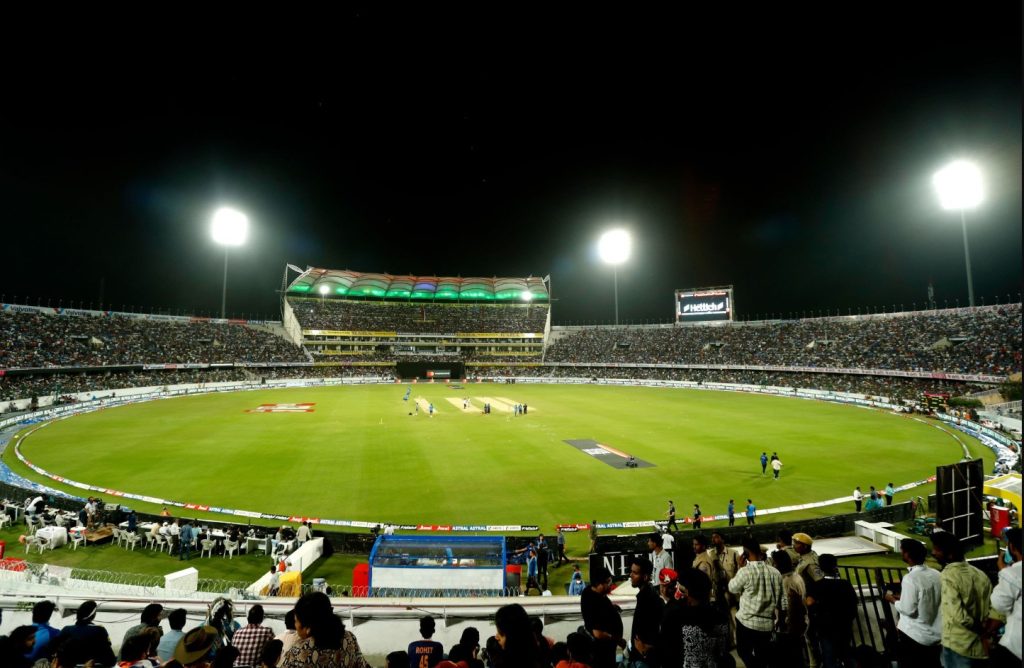Hyderabad: Cricket, as a game, is heavily influenced by the dimensions of the ground on which it is played. The size and layout of a stadium impact strategies, individual performances, and even the final outcome of a match. One such venue that has garnered attention for its dynamic conditions is the Rajiv Gandhi International Cricket Stadium in Hyderabad, India.
Table of Contents
Located in Uppal, this stadium is the home ground of the Sunrisers Hyderabad (SRH) in the Indian Premier League (IPL) and is also frequently used for international matches. With a capacity of around 39,000 spectators, the venue is known not just for its lively crowd but also for its unique boundary dimensions that offer a mix of opportunities and challenges for both batsmen and bowlers.
Ground Overview
| Attribute | Detail |
|---|---|
| Stadium Name | Rajiv Gandhi International Cricket Stadium |
| Location | Uppal, Hyderabad, Telangana, India |
| Established | 2003 |
| Seating Capacity | ~39,000 |
| Home Team (IPL) | Sunrisers Hyderabad |
| Ends | Pavilion End, North End |
Boundary Dimensions Explained
Unlike some sports where fields have standard dimensions, cricket stadiums can differ significantly. Boundary sizes can vary due to pitch positioning, event regulations (ICC vs. IPL), and even seasonal maintenance.
At Hyderabad, the boundaries are typically moderate in size — not as massive as Motera in Ahmedabad, but not as tiny as M. Chinnaswamy in Bengaluru.
Average Boundary Lengths at RGICS
| Boundary Type | Approximate Length (in meters) |
|---|---|
| Straight (down the ground) | 69 – 71 |
| Square (off-side & leg-side) | 63 – 68 |
| Fine Leg / Third Man (behind wicket) | 55 – 59 |
Let’s break these down:
1. Straight Boundary
The distance from the batsman to the sight screen, down the ground, is generally between 69 and 71 meters. These are respectable lengths, meaning players need to time the ball well to clear the boundary, especially against pace bowlers. This is the longest part of the ground and is most used for straight drives and lofted shots over the bowler.
2. Square Boundaries
These are measured on both the leg and off side. At Hyderabad, they are slightly shorter, typically 63 to 68 meters. This plays a significant role in modern cricket where batsmen often target square boundaries with cuts, pulls, and reverse sweeps.
3. Fine Boundaries (Behind Wicket)
These are the shortest at this ground, usually 55 to 59 meters. Smart batsmen often exploit this area with innovative shots like scoops and paddles. These dimensions can be particularly dangerous for bowlers during the death overs in T20s.
Factors Influencing Boundary Size
While these measurements provide a base understanding, they can vary based on several factors:
- Pitch Positioning: Grounds often rotate the pitch within a central block. This affects the length of square and straight boundaries.
- Match Type: ICC regulations often require slightly longer boundaries for international fixtures, compared to IPL games.
- Weather & Ground Conditions: During monsoons or early season games, curators may pull boundaries slightly in to avoid soft patches near ropes.
Comparison with Other Indian Grounds
To understand where Hyderabad stands in comparison, here’s a look at boundary sizes of other major Indian stadiums:
| Stadium Name | City | Straight (m) | Square (m) | Behind Wicket (m) |
|---|---|---|---|---|
| Rajiv Gandhi Intl. Stadium | Hyderabad | 69–71 | 63–68 | 55–59 |
| Eden Gardens | Kolkata | 75–77 | 66–68 | 60–63 |
| M. Chinnaswamy Stadium | Bengaluru | 65–67 | 60–63 | 55–57 |
| Narendra Modi Stadium | Ahmedabad | 75–80 | 70–73 | 65–68 |
| Wankhede Stadium | Mumbai | 67–69 | 63–66 | 58–60 |
How Boundary Dimensions Affect the Game
A. Batting Impact
- Aggressive Openers: Can capitalize on the square boundaries early on.
- Middle-Order Finishers: Often target the fine-leg and third-man areas using unconventional shots.
- Spin Hitter Strategy: Since the boundaries are not too long, batters are more confident lofting against spin in the middle overs.
B. Bowling Approach
- Fast Bowlers: Use yorkers and bouncers to restrict runs, especially since scoops and ramp shots are viable due to shorter fine boundaries.
- Spinners: Tend to bowl slower through the air with more flight to entice mis-hits, hoping for catches near the ropes.
Memorable Matches Influenced by Ground Size
Several matches at this stadium have showcased the significance of boundary dimensions:
- India vs. West Indies T20I, 2019 – India chased down 207, aided by shorter square and fine-leg boundaries.
- SRH vs. RCB, IPL 2016 Final – High scoring final with both teams exploiting dimensions in powerplays and death overs.
- IPL 2023, Hyderabad vs. Chennai – Chennai posted a huge total, utilizing innovative strokes behind the wicket.
The Rajiv Gandhi International Cricket Stadium in Hyderabad is a ground that offers a fascinating blend of dimensions. With straight boundaries that are long enough to challenge, and square and fine boundaries that encourage innovation, it offers something for every type of player. Bowlers need to plan wisely, and batsmen can benefit immensely from studying the boundary lengths and adapting their shot selection accordingly.
The dimensions of this stadium contribute to its reputation as a fair but exciting venue, where high scores are common but not guaranteed, and where cricketing intelligence often trumps brute power.


